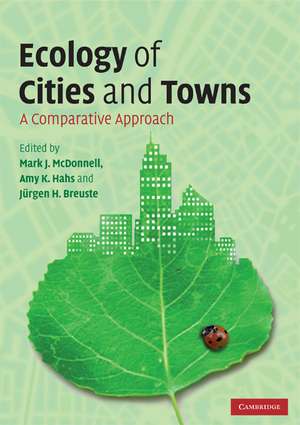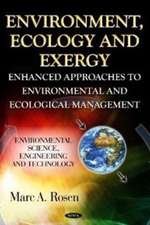Ecology of Cities and Towns: A Comparative Approach
Editat de Mark J. McDonnell, Amy K. Hahs, Jürgen H. Breusteen Limba Engleză Paperback – 24 iun 2009
| Toate formatele și edițiile | Preț | Express |
|---|---|---|
| Paperback (1) | 500.58 lei 6-8 săpt. | |
| Cambridge University Press – 24 iun 2009 | 500.58 lei 6-8 săpt. | |
| Hardback (1) | 922.17 lei 6-8 săpt. | |
| Cambridge University Press – 24 iun 2009 | 922.17 lei 6-8 săpt. |
Preț: 500.58 lei
Preț vechi: 562.44 lei
-11% Nou
Puncte Express: 751
Preț estimativ în valută:
95.79€ • 98.82$ • 79.93£
95.79€ • 98.82$ • 79.93£
Carte tipărită la comandă
Livrare economică 27 martie-10 aprilie
Preluare comenzi: 021 569.72.76
Specificații
ISBN-13: 9780521678339
ISBN-10: 0521678331
Pagini: 746
Ilustrații: 35 b/w illus. 40 tables
Dimensiuni: 168 x 248 x 34 mm
Greutate: 1.46 kg
Ediția:New.
Editura: Cambridge University Press
Colecția Cambridge University Press
Locul publicării:Cambridge, United Kingdom
ISBN-10: 0521678331
Pagini: 746
Ilustrații: 35 b/w illus. 40 tables
Dimensiuni: 168 x 248 x 34 mm
Greutate: 1.46 kg
Ediția:New.
Editura: Cambridge University Press
Colecția Cambridge University Press
Locul publicării:Cambridge, United Kingdom
Cuprins
1. Introduction: scope of the book and the need for developing a comparative approach to the ecological study of cities and towns; Part I. Opportunities and Challenges of Conducting Comparative Studies: 2. Comparative urban ecology: challenges and possibilities; 3. Frameworks for urban ecosystem studies: gradients, patch dynamics and the human ecosystem in the New York metropolitan area and Baltimore, USA; 4. Comparative effects of urbanisation in marine and terrestrial habitats; 5. Comparative ecology of cities and towns: past, present and future; 6. Comparative urban ecological research in developing countries; 7. Using models to compare the ecology of cities; Part II. Ecological Studies of Cities and Towns; 8. Responses of faunal assemblages to urbanisation: global research paradigms and an avian case study; 9. Effect of urban structures on diversity of marine species; 10. Comparative studies of terrestrial vertebrates in urban areas; 11. The ecology of roads in urban and urbanising landscapes; 12. Spatial pattern and process in urban animal communities; 13. Invertebrate biodiversity in urban landscapes: assessing remnant habitat and its restoration; 14. Arthropods in urban ecosystems: community patterns as functions of anthropogenic land use; 15. Light pollution and the impact of artificial night lighting on insects; 16. A comparison of vegetation cover in Beijing and Shanghai: a remote sensing approach; 17. Vegetation composition and structure of forest patches along urban-to-rural gradients; 18. Environmental, social and spatial determinants of urban arboreal character in Auckland, New Zealand; 19. Carbon and nitrogen cycling in soils of remnant forests along urban-rural gradients: case studies in the New York metropolitan area and Louisville, Kentucky; 20. Investigative approaches of urban biogeochemical cycles: New York metropolitan area and Baltimore as case studies; Part III. Integrating Science with Management and Planning: 21. Structural analysis of urban landscapes for landscape management in German cities; 22. Preservation of original natural vegetation in urban areas: an overview; 23. Homogeneity of urban biotopes and similarity of landscape design language in former colonial cities; 24. Tools to assess human impact on biotope resilience and biodiversity in urban planning: examples from Stockholm, Sweden; 25. Landscape ecological analysis and assessment in an urbanising environment; 26. Applying landscape ecological principles to a fascinating landscape: the city; 27. A trans-disciplinary research approach providing a platform for improved urban design, quality of life and biodiverse urban ecosystems; 28. Pattern: process metaphors for metropolitan landscapes; 29. Valuing urban wetlands: modification, preservation and restoration; Part IV. Comments and Synthesis: 30. What is the main object of urban ecology? Determining demarcation using the example of research into urban flora; 31. How to conduct comparative urban ecological research; 32. Ecological scientific knowledge in urban and land-use planning; 33. Envisioning the comparative possible: a critique; 34. Towards a comparative ecology of cities and towns; 35. A comparative ecology of cities and towns: synthesis of opportunities and limitations.
Recenzii
"This important collection argues for a new approcah to ecology, redefining ecology in cities as an ecology of cities, in which the built environment presents a unique set of conditions, associations, and ecosystems....This collection works best as a statement and perhaps predictor of a novel conceptual framework that connects architecture, planning, sociology, and policy with the hard sciences that characterize classical ecology....Recommended."
--Choice
--Choice
Descriere
Assesses the current status, and future challenges and opportunities, of the ecological study, design and management of cities and towns.










